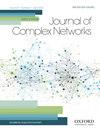Quantifying the temporal stability of international fertilizer trade networks
IF 1.5
4区 数学
Q2 MATHEMATICS, INTERDISCIPLINARY APPLICATIONS
引用次数: 0
Abstract
Abstract The importance of fertilizers to agricultural production is undeniable, and most economies rely on international trade for fertilizer use. The stability of fertilizer trade networks is fundamental to food security. However, quantifying the temporal stability of a fast-growing system, such as the international fertilizer trade, requires a multi-dimensional perception. Therefore, we propose a new method, namely the structural inheritance index, to distinguish the stability of the existing structure from the influence of the growing process. The well-known mutual information and Jaccard index are calculated for comparison. We use the three methods to measure the temporal stability of the overall network and different functional sub-networks of the three fertilizer nutrients N, P and K from 1990 to 2018. The international N, P and K trade systems all have a trend of increasing stability with the process of globalization. The existing structure in the fertilizer trading system has shown high stability since 1990, implying that the instability calculated by the Jaccard index in the early stage comes from the emergence of new trade. The stability of the K trade network is concentrated in large sub-networks, meaning that it is vulnerable to extreme events. The stable medium sub-network helps the N trade become the most stable nutrient trade. The P trade is clearly in the role of a catch-up player. Based on the analysis of the comparisons of three indicators, we concluded that all three nutrient trade networks enter a steady state.量化国际肥料贸易网络的时间稳定性
肥料对农业生产的重要性是不可否认的,大多数经济体都依赖国际贸易来使用肥料。化肥贸易网络的稳定对粮食安全至关重要。然而,量化快速增长的系统(如国际肥料贸易)的时间稳定性需要多维度的感知。因此,我们提出了一种新的方法,即结构继承指数,来区分现有结构的稳定性和生长过程的影响。计算了众所周知的互信息和Jaccard指数进行比较。利用这三种方法对1990 - 2018年氮磷钾三种肥料养分整体网络和不同功能子网络的时间稳定性进行了测量。随着全球化进程的推进,国际氮、磷、钾贸易体系都呈现出日益稳定的趋势。自1990年以来,化肥交易体系的现有结构表现出较高的稳定性,这意味着Jaccard指数计算的早期不稳定性来自于新贸易的出现。K贸易网络的稳定性集中在大的子网络上,这意味着它很容易受到极端事件的影响。稳定介质子网络使氮贸易成为最稳定的养分贸易。P的交易显然是在扮演一个追赶者的角色。通过对3个指标的比较分析,得出3个养分贸易网络均进入稳定状态的结论。
本文章由计算机程序翻译,如有差异,请以英文原文为准。
求助全文
约1分钟内获得全文
求助全文
来源期刊

Journal of complex networks
MATHEMATICS, INTERDISCIPLINARY APPLICATIONS-
CiteScore
4.20
自引率
9.50%
发文量
40
期刊介绍:
Journal of Complex Networks publishes original articles and reviews with a significant contribution to the analysis and understanding of complex networks and its applications in diverse fields. Complex networks are loosely defined as networks with nontrivial topology and dynamics, which appear as the skeletons of complex systems in the real-world. The journal covers everything from the basic mathematical, physical and computational principles needed for studying complex networks to their applications leading to predictive models in molecular, biological, ecological, informational, engineering, social, technological and other systems. It includes, but is not limited to, the following topics: - Mathematical and numerical analysis of networks - Network theory and computer sciences - Structural analysis of networks - Dynamics on networks - Physical models on networks - Networks and epidemiology - Social, socio-economic and political networks - Ecological networks - Technological and infrastructural networks - Brain and tissue networks - Biological and molecular networks - Spatial networks - Techno-social networks i.e. online social networks, social networking sites, social media - Other applications of networks - Evolving networks - Multilayer networks - Game theory on networks - Biomedicine related networks - Animal social networks - Climate networks - Cognitive, language and informational network
 求助内容:
求助内容: 应助结果提醒方式:
应助结果提醒方式:


